Eldepryl dosages: 5 mg
Eldepryl packs: 60 pills, 90 pills, 120 pills, 180 pills, 270 pills, 360 pills
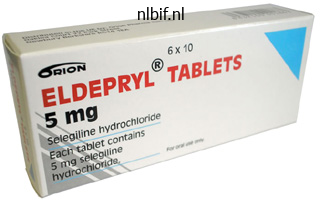
Order 5mg eldepryl with amex
Urodynamic investigations can be helpful to rule out bladder outlet obstruction or significant bladder dysfunction 97110 treatment code generic eldepryl 5mg with visa. In addition to incontinence signs medications ocd generic eldepryl 5mg mastercard, storage and voiding symptoms could additionally be associated (Gray et al medicinenetcom symptoms cheap eldepryl 5 mg online, 1999; Hollenbeck et al medications related to the integumentary system cheap eldepryl 5mg visa, 2002). Urodynamic studies have demonstrated that sphincter incompetence occurs as the only real cause in additional than two thirds of sufferers, whereas isolated bladder dysfunction (detrusor overactivity, poor compliance, detrusor underactivity during voiding) is unusual, occurring in lower than 10% of patients (Ficazzola and Nitti, 1998; Groutz et al, 2000b). However, sphincter and bladder dysfunction can coexist in at least one third of incontinent patients. Decreased sphincter resistance may be brought on by tissue scarring in some instances and is reflected by a low urethral compliance; nevertheless, this parameter is troublesome to measure (Groutz et al, 2000b). Scarring may lead to an anastomotic stricture evidenced by endoscopy or urethrography and may be clinically suspected when both incontinence and decreased force of stream coexist. Urodynamic studies have revealed that a lowered functional urethral size was predictive of incontinence (Hammerer and Huland, 1997; Van Kampen et al, 1998; Wei et al, 2000). Physiotherapy and pelvic flooring rehabilitation have been shown to enhance or improve continence (decreased time to last continence level) in the postoperative period in two randomized research, however provided that such measures are instituted before or immediately after catheter removing (Van Kampen et al, 2000; Parekh et al, 2003). Maximum distinction between physiotherapy and no treatment is achieved at 3 months, with almost no difference at 12 months. A randomized examine in which randomization occurred 6 weeks after surgery confirmed no difference in continence at 6 months (Wille et al, 2003). Urethral bulking theoretically works by adding bulk and rising coaptation at the stage of the bladder neck and proximal urethra. Several agents have been used including bovine collagen (Contigen) and silicone microparticles (Macroplastique). All brokers share comparable problems together with the need for a number of injections, deterioration of effect over time, and low cure rates. InjectionTechniques Retrograde Injection Male sufferers are positioned in the lithotomy place, and the surgical subject is ready within the usual sterile fashion. If native anesthesia is used, 2% topical urethral lidocaine jelly can be inserted 10 minutes before instrumentation. The postprostatectomy urethra is incessantly scarred and not very pliable; thus, a quantity of needle insertions are frequently wanted to deposit sufficient material to produce urethral coaptation. The injection is accomplished in up to four quadrants after localization of the suitable stage in the proximal urethra. The needle is advanced underneath the urethral mucosa with the beveled portion of the needle going through the urethral lumen to enable for layering of the fabric. The injectable materials is then delivered, creating a bleb underneath the urethral mucosa that protrudes into the urethral lumen. This is performed in a circumferential manner in four quadrants, making a bleb in every quadrant. After completion, the urethral mucosa should be utterly coapted, creating the appearance of an obstructed urethra. Extrusion of the injectable agent into the urethral lumen as the needle is withdrawn might happen. This may be prevented generally by leaving the needle in place for no less than 30 seconds after the injection is accomplished or by flushing the material with saline. The loss of extra materials is diminished by preventing development of the cystoscope proximal to the injection sites. If materials extravasation occurs in all quadrants during injection, the process should be terminated and rescheduled (Appell and Winters, 2007). A frequency-volume chart (Griffiths et al, 1993) or bladder diary can be useful. The 24-hour home check is essentially the most accurate pad test for quantification and diagnosis and essentially the most reproducible (Mouritsen et al, 1989). Cystourethroscopy is completed to confirm integrity of the urethral wall and bladder neck and the standing of the bladder. The antegrade method has the benefit of direct visualization of the bladder neck and the injection of material into extra supple, much less scarred urethra. A small suprapubic tube can be positioned to keep away from the possible necessity of urethral catheterization. Urinary retention can be treated by insertion of a fantastic Foley catheter (12 to 14 Fr or smaller) in a single day or intermittent catheterization.
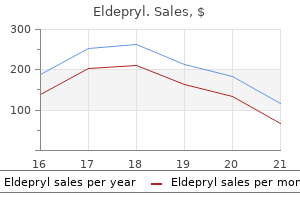
Cheap 5 mg eldepryl with mastercard
However symptoms jet lag order eldepryl 5mg, if augmentation cystoplasty is indicated for renal impairment medicine that makes you poop buy generic eldepryl 5mg, renal function is expected to stabilize or enhance symptoms heart attack women generic eldepryl 5mg with visa. The collection by Ivanci and colleagues (2010) of pediatric sufferers with persistent renal insufficiency undergoing augmentation cystoplasty showed both improvement or no change in renal perform after surgery medications ibs generic 5 mg eldepryl visa. He described the Heister penile clamp, a steel clamp worn across the bottom of the penis to control male urinary leakage (Heister, 1750). This carefully resembles the Cunningham clamp, which is a extensively known exterior fastened urethral compression gadget used at present. MyoplastyforStorageFailure Severe urinary incontinence from sphincteric injury after surgical procedure or a congenital neurologic dysfunction is commonly managed by a sling process, synthetic urinary sphincter, or urethral closure. The use of an autologous muscle switch to kind a neosphincter across the urethra has been reported in a quantity of small scientific collection. Kaufman, one other pioneer in the field of postprostatectomy incontinence therapy, described in several articles an evolution of the Kaufman inside fixed urethral compression process. A thorough dialogue of those up to date surgical remedies for male sphincteric incontinence may be found in Chapter ninety one. In certain male patients with urinary incontinence, exterior mounted urethral compression units still play a task in management. In most instances, continence is achieved by wearing an external system across the penis that compresses the urethra between foam pads. The quantity of compression can be adjusted by the affected person to obtain dryness and minimize pressure-related accidents to the penis. Penile clamps are indicated for sufferers with sphincteric incontinence, often ensuing from prostate surgery. Additionally, external penile compression units should be avoided in patients with impaired sensation or cognition, because these patients are more vulnerable to pressure-related injuries to the penis. Obstruction to penile blood circulate can be minimized by eradicating the device each 3 to four hours and by avoiding usage while sleeping or whereas having an erection. The examine population included 12 men with postprostatectomy incontinence requiring continuous pad protection. Over 4 consecutive days, patients have been randomly assigned to use either one of many three devices or pads alone as a management group. Each group wore the system or pads repeatedly for four hours (maximum time really helpful for continuous usage), and pad weights had been obtained earlier than and after the study interval to quantify leakage. Additionally, patients have been asked to complete a questionnaire on the conclusion of the study. Urine leakage was considerably reduced by all three devices evaluated; nonetheless, the Cunningham clamp was the best of the three gadgets examined, lowering urine leakage by practically 85%. The Cunningham clamp was additionally noted to cut back cavernosal blood flow significantly greater than the other devices. Overall, sufferers rated the Cunningham clamp the most acceptable and preferable of the gadgets evaluated. Female urethral inserts or plugs are available and work by passively occluding the urethral outlet. They must be removed every time a patient voids and require a patient to feel snug with inserting such a tool into the urethra itself. Food and Drug Administration, the Reliance (UroMed) has been withdrawn from the market. Very little is revealed within the literature regarding the outcomes of urethral inserts. However, one study by Sirls and colleagues (2002) reported the results of a 5-year, multicenter trial of one hundred fifty girls with a 15-month follow-up using the FemSoft insert (2002). Pad weight testing and voiding diaries demonstrated efficacy of the insert, and sufferers reported total satisfaction. Although today there are secure and efficient surgical therapies for stress urinary incontinence, some women should still choose a nonsurgical treatment possibility for medical or personal causes. There are numerous intravaginal devices designed to help the anterior vaginal wall and urethrovesical junction, thus improving urethral closure and resistance to will increase in intra-abdominal stress (Bhatia and Bergman, 1985; Komesu et al, 2008). These units include tampons, contraceptive diaphragms, pessaries, and pessary-like units. Most of the studies obtainable are restricted by small numbers and short-term follow-up (Nygaard, 1995; Donnelly et al, 2004; Farrell et al, 2007).
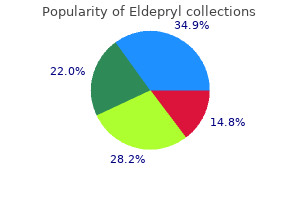
Discount eldepryl 5mg line
Delaying radical cystectomy for muscle invasive bladder cancer leads to worse pathological stage medicine merit badge purchase eldepryl 5mg with mastercard. The danger issue for urethral recurrence after radical cystectomy in patients with transitional cell carcinoma of the bladder medicine qvar inhaler 5mg eldepryl with amex. The management of urethral transitional cell carcinoma after radical cystectomy for invasive bladder most cancers medicine 0025-7974 buy eldepryl 5mg lowest price. Nomograms predicting response to therapy and outcomes after bladder-preserving trimodality therapy for muscle-invasive bladder cancer medications venlafaxine er 75mg safe 5 mg eldepryl. Clinically significant prostate most cancers found incidentally in radical cystoprostatectomy specimens. Defining patient selection for prostate-sparing cystectomy in squamous cell carcinoma of the urinary bladder associated with biharziasis: an overview of 236 patients. Neo-adjuvant chemotherapy in remedy of invasive transitional bladder cancer: a managed, potential randomised examine. Lymph node involvement in sufferers with bladder most cancers handled with radical cystectomy: a patho-anatomical study-a single heart expertise. Adjuvant chemotherapy in invasive bladder cancer: a systematic review and metaanalysis of particular person affected person information. Tumor recurrence in the remnant urothelium of females undergoing radical cystectomy for transitional cell carcinoma of the bladder: long-term outcomes from a single middle. Gemcitabine monotherapy as 2nd line remedy in cisplatin refractory transitional cell carcinoma-prognostic factors for response and enchancment of quality of life. Oncological consequence after radical cystectomy and orthotopic bladder substitution in women. Clinical value of fluorine-18 2-fluoro2-deoxy-D-glucose positron emission tomography/computed tomography in bladder cancer. Predictive factors for invasive prostatic involvement by transitional cell carcinoma. Separate submission of normal lymphadenectomy in 6 packets versus en bloc lymphadenectomy in bladder most cancers. Prostatic involvement by urothelial carcinoma of the bladder: clinicopathological options and outcomes after radical cystectomy. Upper tract recurrences following radical cystectomy: an analysis of prognostic elements, recurrence pattern and stage at presentation. Computerized tomography for detecting perivesical infiltration and lymph node metastasis in invasive bladder cancer. A randomized trial of radical cystectomy versus radical cystectomy plus cisplatin, vinblastine and methotrexate chemotherapy for muscle invasive bladder most cancers. Sequential resection of malignant ureteral margins at radical cystectomy: a crucial assessment of the worth of frozen section analysis. Gemcitabine, cisplatin, and sunitinib for metastatic carcinoma and as preoperative remedy for muscle-invasive bladder cancer. Treatment of sufferers with metastatic urothelial most cancers "unfit" for cisplatin-based chemotherapy. Single-center evaluation of outcomes after remedy for sufferers with clinically localized micropapillary urothelial carcinoma of the bladder. Radical cystectomy for carcinoma of the bladder: 2,720 consecutive instances 5 years later. Do sufferers benefit from routine follow-up to detect recurrences after radical cystectomy and ileal orthotopic bladder substitution Erection and ejaculation-preserving cystectomy with orthotopic urinary diversion: is it possible Neoadjuvant therapy for regionally superior bladder cancer: a randomized prospective scientific trial. Mortality increases when radical cystectomy is delayed greater than 12 weeks: outcomes from a Surveillance, Epidemiology, and End Results-Medicare evaluation. Double-blind, randomized, section 2 trial of maintenance sunitinib versus placebo after response to chemotherapy in patients with advanced urothelial carcinoma. Errata for: Neoadjuvant chemotherapy plus cystectomy in contrast with cystectomy alone for locally advanced bladder cancer. Pathological upstaging during radical cystectomy is associated with worse recurrence-free survival in sufferers with bacillus Calmette-Guerin-refractory bladder cancer. Impact of adjuvant chemotherapy on patients with lymph node metastasis at the time of radical cystectomy.

Buy 5 mg eldepryl fast delivery
Again that is confirmed with frozen section analysis symptoms ketoacidosis best eldepryl 5 mg, and additional resection may be essential cold medications generic eldepryl 5mg overnight delivery. Bladder augmentation with the usage of an intestinal section may be performed if bladder capability is significantly lowered medications routes purchase 5mg eldepryl fast delivery. In addition to this complexity denivit intensive treatment buy 5mg eldepryl visa, patients are regularly elderly and current with significant comorbidities. Postoperative efforts are essentially directed at minimizing the potential for complications and maximizing the return of normal physiology. Immediately after surgery, laboratory results including cell count, electrolytes, and renal function are assessed and fluid dynamics are monitored. Frequently patients will require initial statement in intensive care or stepdown items. As mentioned earlier, thromboembolic prophylaxis should be continued in the postoperative setting in the absence of hemorrhage. In addition to pharmacologic measures, early ambulation should be used and pulmonary exercise (incentive spirometry) with deep respiration and coughing should be inspired. Delayed return of bowel operate frequently prolongs hospitalization after radical cystectomy. Medications such as alvimopan can be utilized, which has been shown to improve return of bowel perform and to shorten hospital stays. Additional postoperative steps to improve restoration embody neostigmine (with telemetry monitoring) to encourage additional the return of bowel function, promotility suppositories, stress ulcer prophylaxis, antiemetics, early enteral feeding in the absence of nausea and/or emesis, and avoidance of narcotic pain treatment (ketorolac and acetaminophen except contraindicated) (Djaladat and Daneshmand, 2013). Radical surgical procedure for carcinoma of the urinary bladder: one hundred consecutive circumstances four years later. Herr whose work on the previous version of this chapter was invaluable within the preparation of the current text. Urethral recurrence of transitional cell carcinoma of the bladder: predictive worth of preoperative latero-montanal biopsies and urethral frozen sections throughout prostatocystectomy. Gastrointestinal tract recovery in patients undergoing bowel resection: outcomes of a randomized trial of alvimopan and placebo with a standardized accelerated postoperative care pathway. Radical cystectomy for bladder most cancers today-a homogeneous sequence with out neoadjuvant therapy. Resection of ureteral orifice throughout transurethral resection of bladder tumor: practical and oncologic implications. Effect of gender on outcomes following radical cystectomy for urothelial carcinoma of the bladder: a critical evaluation of 1,994 sufferers. Local recurrence and survival following nerve sparing radical cystoprostatectomy for bladder most cancers: 10-year followup. Is there a sign for frozen part examination of the ureteral margins throughout cystectomy for transitional cell carcinoma of the bladder Orthotopic urinary diversion with preservation of erectile and ejaculatory function in males requiring radical cystectomy for nonurothelial malignancy: a brand new technique. Cystectomy with prostate sparing for bladder cancer in a hundred patients: 10-year experience. The association between extent of lymphadenectomy and survival among sufferers with lymph node metastases undergoing radical cystectomy. No advantage is gained by preoperative bowel preparation in radical cystectomy and ileal conduit: a randomized managed trial of 86 patients. Colon and rectal surgery with out mechanical bowel preparation: a randomized potential trial. Perioperative intravesical chemotherapy in non-muscle-invasive bladder cancer: a scientific evaluate and meta-analysis. Sexual operate after nonnerve-sparing radical cystoprostatectomy: a comparability between ileal conduit urinary diversion and orthotopic ileal neobladder substitution. Computerized tomography for detecting perivesical infiltration and lymph node metastasis in invasive bladder carcinoma. Combined ultrasmall superparamagnetic particles of iron oxide-enhanced and diffusion-weighted magnetic resonance imaging facilitates detection of metastases in normalsized pelvic lymph nodes of patients with bladder and prostate most cancers. Prospectively packaged lymph node dissections with radical cystectomy: analysis of node depend variability and node mapping. [newline]Incidence and location of lymph node metastases in patients undergoing radical cystectomy for clinical non-muscle invasive bladder cancer: results from a potential lymph node mapping research. Long-term outcomes of salvage radical cystectomy for recurrent urothelial carcinoma of the bladder following partial cystectomy.
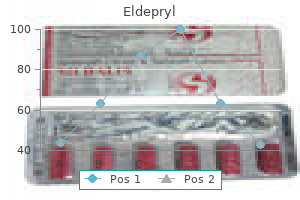
Order 5mg eldepryl visa
With the help of a self-retaining retractor corresponding to a Bookwalter medicine quiz quality 5 mg eldepryl, exposure is maximized and the bowel retracted cephalad symptoms 0f parkinson disease discount eldepryl 5 mg free shipping. Communication with the anesthesiologist at this level is significant to be sure that inadvertent compression of the vena cava has not resulted medications hyperthyroidism purchase 5 mg eldepryl amex. A moistened laparotomy pad or pads must be positioned behind retractor blades to defend the belly contents medicine 4h2 eldepryl 5 mg without prescription. After adequate exposure is achieved, the bilateral ureters are dissected free from their attachments beginning a few centimeters above the place they cross the iliac arteries to the level of the detrusor hiatus. The superior vesical artery must be ligated and divided before finishing the ureteral dissection as this aids in maximizing ureteral size. The ureter is then controlled with both suture ties or suture ligature and is divided. Although controversial, the distal ureteral margin can be despatched for frozen part analysis to consider for the presence of urothelial carcinoma. Although research have shown a correlation between findings of carcinoma in the ureteral margin and subsequent higher tract recurrence (Schumacher et al, 2006), an impact on survival has not been well established (Raj et al, 2006). Additionally the research by Raj and colleagues indicated that despite sequential resection to achieve a negative margin in forty eight cases of an initial optimistic ureteral margin, upper tract recurrence was not eliminated (Raj et al, 2006). According to surgeon desire, short-term ureteral catheters directed off the surgical subject can be used to maintain urinary flow during the remainder of the process, or the ureters can be temporarily ligated to keep away from spillage of urine into the operative field. The anatomic boundaries of a regular template dissection consist of the genitofemoral nerves laterally, the interior iliac artery medially, Cooper ligament inferiorly, and the purpose at which the ureter crosses the frequent iliac artery superiorly. In cases of advanced illness, an prolonged dissection inclusive of the complete widespread iliac lymph node packet and the presacral lymph node packet could be obtained. Although additional extension cephalad to embrace the para-aortic packet to the level of the inferior mesenteric artery has been studied in bladder cancer, none have demonstrated any additional staging info beyond a dissection from the common iliac arteries distally (Bochner et al, 2004, Bruins et al, 2014). Care must be taken throughout lymphadenectomy to avoid injury to the obturator nerve and to ensure control of lymphatics on the caudal and cephalad extremes. Surgical quality as measured by nodal yield has demonstrated a survival benefit in bladder most cancers. Herr (2004) and colleagues found that in sufferers in whom a minimum of 10 lymph nodes have been eliminated, 5-year survival improved from 44% to 61%. B, Distributions of the eight node packets from an prolonged pelvic and retroperitoneal lymph node dissection. Completion of the pelvic lymphadenectomy aids in the publicity and identification of the vascular pedicles to the bladder. Control of the primary branches to the bladder, including the superior, middle, and inferior vesical arteries, may be achieved with assistance from a vascular stapler. The rectal cul-de-sac is identified and the peritoneum is incised the place it overlies the seminal vesicles. The rectum is dissected free with both blunt dissection or sharp dissection in the midline and is carried to the extent of the prostate, at which level Denonvilliers fascia is encountered and incised. In circumstances of superior disease, earlier pelvic radiation, or reactive fibrosis from earlier resection or intravesical chemotherapy, difficulty in creating this plane could additionally be encountered. Instead, under direct visualization, sharp dissection ought to be carried out with care taken to keep rectal integrity. If a rectal damage is encountered, primary repair with or with out flap coverage and/or bowel diversion should be performed (Kozminski et al, 1989). After launch of the rectum in the midline, dissection is carried laterally and the posterior vesical pedicles are identified. Similar to the lateral pedicles, they are often managed with surgical clips, ties, vascular staplers, or sealing instruments. A, the posterior airplane beyond the cul-de-sac, which separates the bladder and prostate from the rectum. With a gloved finger surgeons ought to protect the rectum from the information of such instruments while in use. After completion of the posterior dissection, the urethra must be palpable and at this point consideration could be turned to the anterior dissection in a style just like a radical prostatectomy. The endopelvic fascia overlying the levator muscular tissues is incised sharply, allowing for identification of the confluence between the urethra and the dorsal venous complicated. If continent ileal neobladder urinary diversion is deliberate, enough urethral length have to be maintained and a frozen section analysis of the urethral margin performed. In a study of 436 patients who underwent eight cutaneous or orthotopic diversions, urethral recurrence occurred in 7.
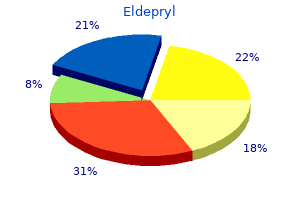
Buy eldepryl 5 mg amex
Catheter choice is variable medications vertigo generic 5mg eldepryl, but a 12- to l6-Fr delicate catheter may be used for males and a brief (6-inch "female") 12- to 16-Fr catheter for females medications safe while breastfeeding eldepryl 5 mg cheap. Larger catheters could additionally be required in sufferers with a prior bowel augmentation or those that require bladder irrigation symptoms for mono eldepryl 5mg free shipping. Anticholinergic treatment ought to be thought of when urine leakage happens between catheterization intervals or if high storage pressures develop medicine 512 order 5 mg eldepryl mastercard. At a minimal, we consider that urodynamics ought to be performed after the initial neurologic damage is secure and whenever any important changes in continence or voiding perform occur. The long-term efficacy and security of such a program has been demonstrated by Lapides and others (Weld and Dmochowski, 2000). The patient should have sufficient hand control, or a member of the family have to be prepared to carry out the catheterization. Graham (1989) reported on the factors required to successfully develop a catheterization program for sufferers with useful limitations, which generally exists in sufferers with neurogenic bladder dysfunction. It is advantageous to have a devoted nurse who instructs the sufferers and households in the catheterization regimen; provides them with comprehensible written directions to refresh their memory concerning technique, precautions, and danger signals; and offers continuing support for sufferers and families who name with questions or problems regarding their regimen. Many sufferers are initially reluctant to perform any procedure on their very own genitalia. Intermittent catheterization could also be carried out by clear, aseptic, or sterile methods (Hudson and Murahata, 2005). It is washed, generally with cleaning soap and water, and allowed to air-dry earlier than storage. When reusing catheters, some have advocated boiling or microwaving for sterilization (Douglas et al, 1990). Any affected person requiring intermittent catheterization could acquire up to 200 sterile catheters per thirty days for one-time use. This change in coverage has negated the need for reusing catheters in most sufferers, but it nonetheless may be necessary in patients without insurance protection or different financial limitations. For grownup patients, catheterization is ContinuousCatheterization Long-term indwelling catheters should be thought-about when anatomic, practical, or familial limitations prohibit efficiency of intermittent catheterization. Long-term catheterization may be achieved by either a urethral or suprapubic catheter. Overall, suprapubic catheters have been related to excessive rates of patient satisfaction. Barnes and associates (1993) concluded that long-term suprapubic catheters have been properly tolerated by patients with neuropathic bladders. Based on the replies of 32 sufferers who expressed an opinion, 84% had been satisfied; however, the follow-up was short (mean 23 months), and in 2 of 12 patients assessable at over 2 years, creatinine ranges elevated. Other issues occurred, including recurrent catheter blockage in 38%, recurrent symptomatic urinary infections in 23%, and displaced catheters requiring reinsertion within the working room in 15%. Urethral leakage occurred in eight of 14 females with a suprapubic catheter alone and in 6 of sixteen males. Sheriff and associates (1998) mentioned the clinical outcomes in a satisfaction survey of 185 sufferers with neuropathic bladder dysfunction treated with long-term suprapubic catheterization (follow-up, three to sixty eight months; mean, 24 months). In addition, only 103 of the 185 patients crammed out the satisfaction questionnaire, and solely eight sufferers had a suprapubic catheter for longer than 2 years. Complications on this group included 5 sufferers with a small bowel damage during insertion, 2 with vital hemorrhage, 2 requiring catheter repositioning, 1 requiring reinsertion due to dislodgement, 8 with persistent incontinence, and 18% with recurrent catheter blockage. Bacteriuria existed in 98% of the sufferers, but recurrent symptomatic an infection occurred in only 4%. A controversial concern, widespread to all long-term indwelling catheters, is the development of bladder cancer. Several others reported similar findings (Chao et al, 1993; Stonehill et al, 1996). Since these stories, the association between chronic indwelling catheterization and the event of bladder carcinoma has been debated. Chronic inflammation is the most likely causative issue and could additionally be brought on by the indwelling catheter itself, bladder calculi, and/or recurrent infections.
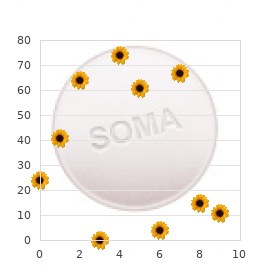
5 mg eldepryl
After 1 year medicine cabinets surface mount best eldepryl 5mg, 7 reported substantial enchancment medications zovirax buy 5mg eldepryl with mastercard, 2 improved medicine to calm nerves order 5mg eldepryl with mastercard, and 1 had no change medications diabetic neuropathy eldepryl 5 mg without prescription. It consists of two inflatable silicone balloons attached to silicone tubing with a titanium and silicone port. The balloons are positioned into the periurethral area at the bladder neck with introducer gadgets inserted through two 1-cm incisions in the labial sulci at the degree of the vaginal introitus. The procedure is carried out underneath fluoroscopic steering with a contrastfilled Foley balloon positioned on the bladder neck. After the right place is ascertained, the system balloons are inflated with 1 to 1. The aim is to increase urethral resistance and help the bladder neck with the inflated balloons (Stecco et al, 2006). The ports are buried in the subcutaneous tissue of the labia to enable postoperative reinjection of the balloons if necessary (Kocjancic et al, 2008). However, 26 sufferers underwent explantation, and thirteen records had been incomplete or had been missing knowledge. Kocjancic and colleagues (2008) carried out implantation in 49 patients, of whom 38 have been adopted for greater than 1 12 months. Of these, 26 of 38 (68%) have been dry, 6 of 38 (16%) improved, and in 6 of 38 (16%) the process failed. In 62%, one to 5 fluid additions had been necessary all through the follow-up interval. The dry price was 44%, marked enchancment was seen in 15%, and 41% had slight improvement or no change. In a subsequent sequence, Kocjancic and colleagues (2010), reported 6-year outcomes on 29 of fifty seven patients. On the Patient Global Impression of Improvement questionnaire, 64% of sufferers rated their symptoms as very much improved, 23% as a lot improved, and 13% as minimally improved or unchanged. In a second report from the North American multicenter examine, Aboseif and coworkers (2011) reported on 1-year outcomes in 77 of 89 sufferers. Complications have occurred in 24% (Aboseif et al, 2009) to 39% (Wachter et al, 2008) of patients, with most categorised as mild to reasonable. Intraoperative urethral or bladder perforation has been reported in 3% to 17% of sufferers. During the first year postoperatively, problems reported are balloon migration (6. Others embrace urethral erosion (2% to 15%), cutaneous erosion of the port (3% to 75%), device an infection (0. However, cell-based therapies have demonstrated experimentally a rise in most or all the parts of the sphincter mechanism. Because of the potential threat of tumor formation and immunologic and ethical concerns, potential use of these cells is restricted. Their limitations of mortality and restricted differentiation potential additionally might make them safer (Staack and Rodriguez, 2011). The cells may be expanded before transplantation in a tradition medium and may release paracrine factors to stimulate surrounding tissue regeneration. Large numbers of progenitor cells with a specialised phenotype could be obtained by in vitro development. To avoid the necessity for expensive cell preparation expertise, Gras and colleagues examined the effect of transurethral injection of minced autologous striated muscle harvested and ready to be used on the time of urethral injection (Gras et al, 2014). After 12 months, remedy and improvement have been famous in 25% and 63% of the uncomplicated group and 7% and 57% of the difficult group, respectively. Peters and colleagues (2014) reported that biopsy-related adverse occasions occurred in 4 patients and included wound hematoma (2), procedural dizziness and associated responses (2), postoperative bleeding requiring sutures (1), and joint swelling (1). Injection procedure-related opposed occasions occurred in 18% (14 of 80), and included dysuria (7), pelvic or belly pain (4), vulvovaginal pruritus (3), urinary urgency (2), and transient hematuria (2). Furthermore, the last word value of the technology will decide whether it becomes a feasible different. The cells survive and a traditional restore process happens with formation of latest innervated myofibers, easy muscle cells, loose interstitial tissue, and vessels. These observations have been confirmed by histologic and immunohistochemical checks. Functional testing on isolated urethral tissue and urodynamic checks on complete animals even have supported the outcomes (Gras and Lose, 2011).
References
- Burroughs S, Bowrey DJ, Morris-Stiff GJ, Williams GT. Granulomatous inflammation in sigmoid diverticulitis: two diseases or one? Histopathology 1998;33:349.
- Zimskind PD, Davis DM, Decaestecker JE: Effects of bladder filling on ureteral dynamics, J Urol 102:693, 1969.
- Scott-Emuakpor AB, Warren ST, Kapur S, Quiachon EB, Higgins JV. Familial occurrence of congenital pulmonary lymphangiectasis. Genetic implications. Am J Dis Child 1981;135:532-4.
- Rabe KF, Adachi M, Lai CKW, et al. Worldwide severity and control of asthma in children and adults: the global asthma insights and reality surveys. J Allergy Clin Immunol 2004; 114: 40-47.
- Hurlbert RJ. Pharmacologic management of acute spinal cord injury. In: Vaccaro AR, Fehlings MG, Dvorak MF, eds. Spine and Spinal Cord Trauma: Evidence-Based Management. New York, NY: Thieme Medical Publishers; 2011:87-94.
- Beard, R. W., Highman, Pearce, & Reginald. (1984). Diagnosis of pelvic varicosities in women with chronic pelvic pain. Lancet, 2, 946.
- Bennell KL, Dobson F, Roos EM, et al. The influence of biomechanical characteristics on pain and function outcomes from exercise in medial knee osteoarthritis and varus malalignment: exploratory analyses from a randomised controlled trial. Arthritis Care Res 2015; 67(9):1281-8.

